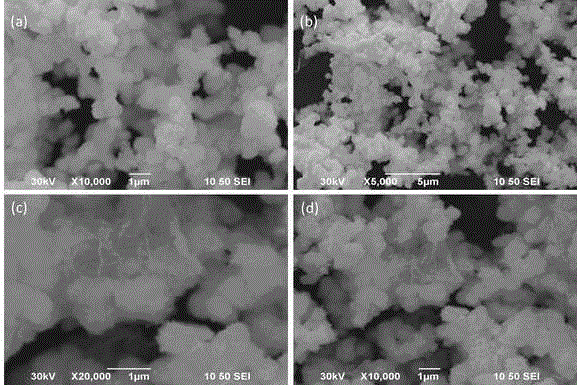A preparation method of bismuth oxyfluoride/graphene composite visible light catalyst
A graphene composite and bismuth oxyfluoride technology, which is applied in the direction of light water/sewage treatment, energy wastewater treatment, etc., can solve the problems of no discovery, etc., and achieve the effects of stable performance, strong market application prospects, and wide absorption spectrum range
- Summary
- Abstract
- Description
- Claims
- Application Information
AI Technical Summary
Problems solved by technology
Method used
Image
Examples
Embodiment 1
[0014] 2.5mmol Bi(NO 3 ) 3 ∙5H 2 O was added to 20 mL ethylene glycol, and until it was completely dissolved, solution X was obtained; 2.5 mmol NaF was dissolved in 20 mL ethylene glycol, and solution Y was obtained after it was completely dissolved; solution X and solution Y were mixed dropwise (approx. 2mL / min) by adding 100mL deionized water to obtain a white precipitate, which was filtered, washed with deionized water and ethanol three times each, and the filtered product was dried in a constant temperature drying oven at 80°C for 5h, and then kept at 300°C for 2h to obtain A spherical bismuth oxyfluoride photocatalyst with a particle size of 800nm. The RhB removal rate of Rhodamine B dye wastewater was degraded under natural sunlight for 8 hours was 50%.
Embodiment 2
[0016] 2.5mmol Bi(NO 3 ) 3 ∙5H 2 O was added to 20 mL ethylene glycol, and until it was completely dissolved, solution X was obtained; 2.5 mmol NaF was dissolved in 20 mL ethylene glycol, and solution Y was obtained after it was completely dissolved; solution X and solution Y were mixed dropwise (approx. 2mL / min) by adding 100mL deionized water to obtain a white precipitate, which was filtered, washed with deionized water and ethanol three times each, and the filtered product was dried in a constant temperature drying oven at 80°C for 5h, and then kept at 300°C for 2h to obtain Spherical bismuth oxyfluoride with a particle size of 800nm; add 1.52mg of graphene oxide into 50mL of deionized water, ultrasonically disperse for 60min to form a graphene oxide aqueous solution, add 2.5mmol spherical bismuth oxyfluoride to the graphene oxide aqueous solution, and continue to Stir for 2 hours; then transfer to a constant temperature water bath, add 0.025mL hydrazine hydrate, reduce t...
Embodiment 3
[0018] 2.5mmol Bi(NO 3 ) 3 ∙5H 2 O was added to 20 mL ethylene glycol, and until it was completely dissolved, solution X was obtained; 2.5 mmol NaF was dissolved in 20 mL ethylene glycol, and solution Y was obtained after it was completely dissolved; solution X and solution Y were mixed dropwise (approx. 2mL / min) by adding 100mL deionized water to obtain a white precipitate, which was filtered, washed with deionized water and ethanol three times each, and the filtered product was dried in a constant temperature drying oven at 80°C for 5h, and then kept at 300°C for 2h to obtain Spherical bismuth oxyfluoride with a particle size of 800nm; add 3.05mg of graphene oxide into 50mL of deionized water, ultrasonically disperse for 60min to form a graphene oxide aqueous solution, add 2.5mmol spherical bismuth oxyfluoride to the graphene oxide aqueous solution, and continue to Stir for 2 hours; then transfer to a constant temperature water bath, add 0.05mL hydrazine hydrate, reduce th...
PUM
| Property | Measurement | Unit |
|---|---|---|
| particle diameter | aaaaa | aaaaa |
Abstract
Description
Claims
Application Information
 Login to View More
Login to View More - R&D
- Intellectual Property
- Life Sciences
- Materials
- Tech Scout
- Unparalleled Data Quality
- Higher Quality Content
- 60% Fewer Hallucinations
Browse by: Latest US Patents, China's latest patents, Technical Efficacy Thesaurus, Application Domain, Technology Topic, Popular Technical Reports.
© 2025 PatSnap. All rights reserved.Legal|Privacy policy|Modern Slavery Act Transparency Statement|Sitemap|About US| Contact US: help@patsnap.com

